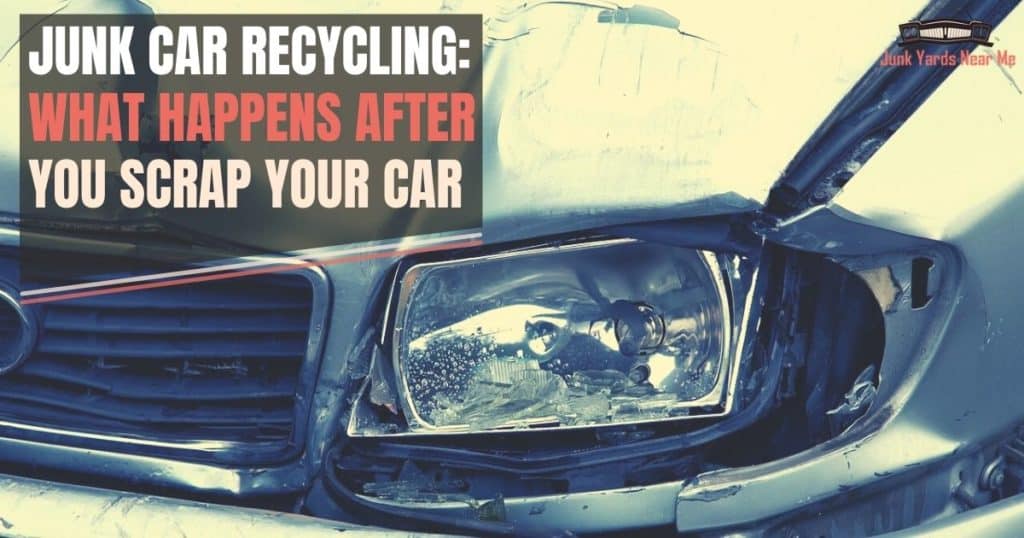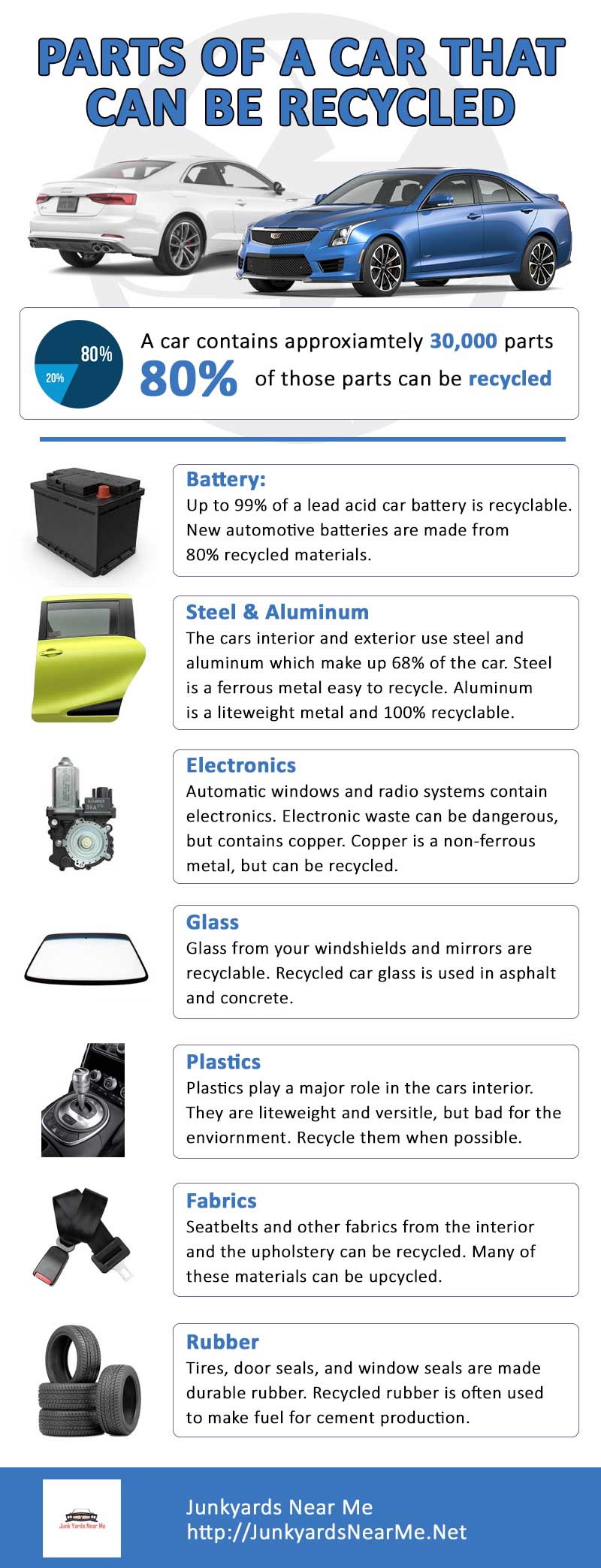
In the U.S. junk cars are the number one most recycled product. With a car having approximately 30,000 parts where does it all go? What does junking a car actually produce? Well today well discuss junk car recycling. Here you will learn what happens after you sell you car to your local salvage yard for cash.
When you scrap a junk car, it doesn’t just get pulled apart the next day or become scrap metal. A junk car goes through several phases of the recycling process. The good news is though, not much of it will end up in a landfill.
What Happens When I Scrap My Junk Car?
When a car hits the auto salvo the automobile recycling process begins. It will go through a series of having fluids drained, parts pulled off for reuse and resale, parts like dead batteries and bald tires are pulled for recycling, and then the remaining steel, aluminum and metals, gets scraped. Not all salvos will remove all recyclable components from a car. They often only do it because it is in their financial interest. NOTE: If you are junking a vehicle, you should consider removing any PII data in it for vehicles made after 2008.
Parts of a Junk Car that Can Be Recycled
80 to 85% of cars these days can be recycled, leaving little to go to your local landfill. The below graphic shows you the basic car parts for junk car recycling.

Now that you have a basic idea of what parts of a car can be reused or recycled, let’s dive into more detail.
Draining the Fluids
Vehicles have many types of fluids like engine oil, antifreeze, fuel, Freon, transmission fluid, brake fluid, power steering fluid, etc. You wouldn’t want of these fluids to leak into the ground and contaminate the ground water. The average junked car has about 10 gallons of fluid still in it. Some of these will recycled, while others will be resold and reused.
While it may seem like dumping fluids is the easy way to go, it is very hazardous to do so. Recycling is the responsible thing to do for the environment, but it also makes financial sense. Recycling the fluids uses less energy then making new products from scratch. Here are some of the products that are a result from recycling fluids from junked autos:
- Motor Oil: Gets cleaned and reused as a lubricant. Also can be repuposed as fuel for running a furnace.
- Freon: Repurposed as a refrigerant.
- AntiFreeze: Gets cleaned and reconditioned and can be resold as antifreeze.
Pulling Parts for Reuse and Resale
Even a junked car sent to the scrap yard might still have parts worth money. A salvage yard will either pull parts for resale or put the vehicle out for pick and pull before it is crushed. Often when sold as individual parts it can make up for more then the value that the salvage paid for the car.
Some of the most standard parts that get pulled are transmissions, engines, starters, alternators, batteries, and axels. Other parts like doors, bumpers, mirrors, hoods, are also popular. Typically parts that start to corrode first get pulled first and sold for more money.
Junk Car Parts That Get Recycled – Avoid the Landfill
Not all parts recycle as easy as others.
- Batteries: 98% of all car batteries get recycled. 90% of the lead gets reused in new batteries. Almost 100% of the plastic gets melted down and reused to make new battery casings. If a battery is still good it can be resold as is. If there is still a little charge, left it can be recharged and resold.
- Tires: The rubber on tires can have many uses. About 60% of all recycled tires become a fuel source for industrial boilers, paper mills, and cement kilns. 30% get turned into crumb rubber for gym mats, synthetic turf, soil fillers, running tracks and other applications. Ideally though if the tire still is in good structural shape and has tread left it can resold and reused for it’s intended purpose.
- Plastic: Almost 50% of a new car is made of plastic which likely came from other recycled plastic such as plastic caps, bottles, and packing material. Recycling the car plastic gets turned into other new car parts and sometimes appliances.
The key to recycling car parts is really about keeping these items out of your local dumps and landfills. Lead from the batteries is toxic to the environment and things like tires take 50 to 80 yrs to degrade. Even taking these items to your local recycling center is a good idea instead of your local dump.
What Happens to the Scrap Metals?
Different metals get different treatment, based if they are ferrous or non-ferous, which indicates if they contain Iron. They also have different market values in the scrap metal world.
- Steel: 60% percent of a car’s weight is steel and iron. Over 18 million tons annually or recycled. At a scrap metal yard, once a car is drained of fluids, its flattened. Then a big shredding machine separates the steel from other materials. This is done with monster size magnets. About 25% of the scrap steel will go right back into new cars. It will be used to make doors, hoods, trunks, and other panels. Much of the rest of the scrap steel will be used for appliances, airplane hangers, bridges, elevators, construction material, etc…
- Aluminum: 90% of a vehicles aluminum can be recycled as new car parts. This is important because car manufacturers are using more aluminum to decrease vehicle weight for fuel efficiency. Some of the aluminum parts on cars are wheels, engine heads, transmission cases, and radiators. Newer cars might even have aluminum fenders and hoods.
- Typical Platinum Group Metals (PGM): This group includes platinum, palladium, and rhodium which are used in automobiles. These are known as precious metals and it makes them very valuable on the scrap metal market. You can find small amounts of these rare metals in catalytic converters. These get resold by weight and can yield a huge return, but unfortunately they are hard to recover. Usually only 1 to 15 grams of these metals get recovered per vehicle, depending on the size. They get repuposed to make new catalytic converters.
The Benefits of Recycling Cars
The main benefit of junk car recycling is the environmental impact it has.By recycling Steel we use less energy then it takes to manufacture new steel. This helps reduce the depletion of our natural resources. Producing steel requires large amounts of coal, which release greenhouse gases and create pollution. When we reuse steel, we don’t need to produce new steel and therefore create less greenhouse gases and reduce the environmental strain. Also steel mining in itself creates land erosion and leach soil pollutants and impacts all of the local wildlife. This has enormous ramifications on the long term sustainability of the local environment
Landfill waste reduction is another benefit. Imagine how much space a vehicle would take up in a landfill, not to mention the dangerous chemicals that could leak from it. These chemicals and additional pollutants in the soil could contaminate the ground water. Tires in landfills also take 50-80 years to degrade. They also destroy landfill liners and take up a lot of space considering almost 75% of a tire is void.
